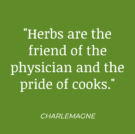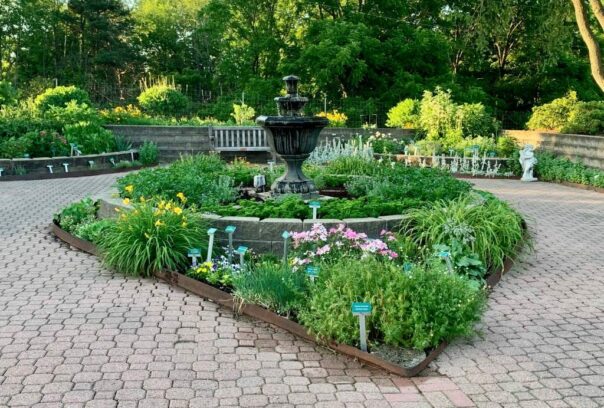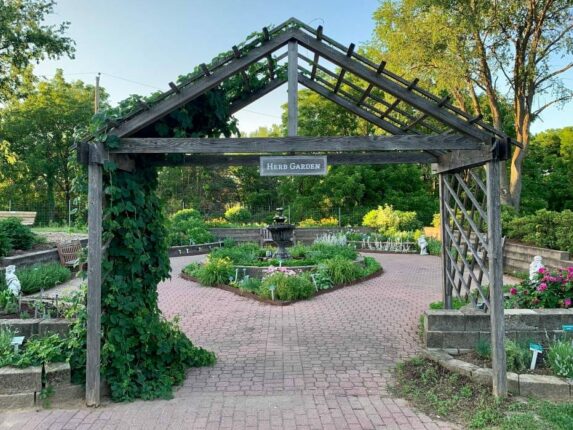Formal Herb Garden
The entrance to the Formal Herbal Garden is framed by a wooden arch with signage identifying the garden. The arch supports a hop plant. The hop blooms can be used in dream pillows and to make wreaths. On each side of the arch are raised beds featuring chive and lavender plants.
The ground level garden is divided into four quadrants, and an eye shaped area. Above the “eye” is a fountain surrounded by a raised circular bed.
The four quadrants:
- Tea. This garden is dedicated to herbs that can be used to make an herbal infusion, more correctly called a tisane. Herbal teas have been brewed for thousands of years. In this quadrant you will find rosa rugosa, bee balm, coneflower, lemon balm, catmint, and other herbs that vary year to year. The border around this garden contains varieties of mint.
- Culinary. The culinary garden features herbs that add flavor, texture, and color to our meals. If you love to cook (or eat), stop by this quadrant for inspiration. You’ll find varieties of basil, sage, French tarragon, lovage, fennel, and more.
- Aromatic. In the aromatic — or scented — garden, are plants grown primarily for their fragrance. While many of them are sweet-scented (such as, lavender, rose, and the scented geraniums) others give off an aroma that is designed to deter insects.
- Medicinal. Plants that have been used for thousands of years to treat a variety of diseases are found in the medicinal garden — comfrey, echinacea, and St. John's Wort are all ancient medicinal plants.
Other areas:
- The “Eye,” named for its shape, features edible flowers. Nasturtiums, pansies, roses, pineapple sage, calendula, day lilies, and dianthus make lovely garnishes. Some of these flowers can be added to soups and others to salads.
- The circular area surrounding the fountain is dedicated to curly and flat-leafed (Italian) parsley.
- The Dye Bed is located above the back wall of the garden. It highlights plants that have been used for hundreds of years to dye fabric. Look for baptisia (false indigo), coreopsis, calendula, bee balm, and more. In recent years, there has been a revival of interest in natural, plant-based dyes.
WITH APPRECIATION Care and maintenance of the Formal Herb Garden is the task of the Herb Society of Dubuque and its members.






